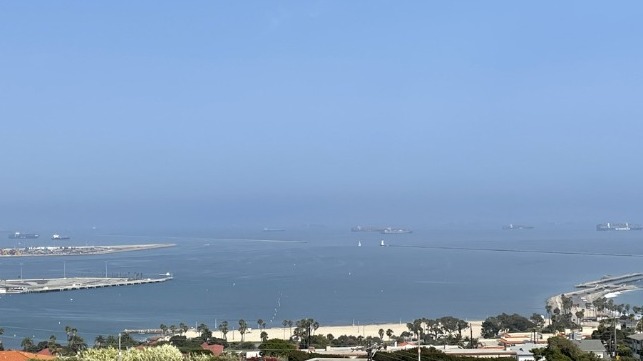Vessel Congestion Sets Two New Records in Southern California

After months of reported progress on reducing the backlog at the two largest ports in Southern California, the congestion has again spiked to record levels. The Marine Exchange of Southern California, which oversees the movement of vessels at the ports of Los Angeles and Long Beach, reports that new records were set for the number of vessels in port and at the anchorage and despite slight declines they expect the volumes to continue at these elevated levels in the coming days.
“We set two records over the weekend,” says Captain Kip Louttit, Executive Director of the Marine Exchange of Southern California. “Regular and contingency anchorages remain essentially full,” he reported in his daily update to the maritime community while assuring everyone despite the record levels the port system remained safe and secure. Louttit writes the port system is “as efficient as can be under COVID-19 conditions due to the great work of all port partners and every segment of the workforce.”
The first record came on Friday, August 13, when there was a total of 125 vessels in port at the San Pedro Bay port complex. By Monday, it had declined just slightly to 116 vessels with 59 on berth and 57 waiting offshore in the anchorage or drift areas. Within the ships, there were 28 containerships on berth at the two ports while an additional 35 were waiting offshore. The total of 63 containerships, however, was just slightly below the absolute record of 67 on January 30, 2021, and the 35 at anchor was below the peak of 40 on February 1, 2021. By comparison, in 2015 there was a record 28 containerships in the San Pedro Bay.
On August 14, the San Pedro Bay set a second record with a total of 68 ships in the anchorage, including the use of four drift areas. In January 2021, the port complex had set a record with 60 vessels in the anchorage compared with a record six years earlier of 48 total vessels in the anchorage.
For the second time this year, the Marine Exchange has also been forced to open drift areas because the primary anchorage and overflow areas are full. In January 2021, they opened the drift areas for the first time in seventeen years. Louttit explains that the drift areas are assigned working with the captain of vessels to chose a safe location at least two miles from shore and another vessel as well as the shipping lanes. Vessels are monitored in these locations for safety and offered positions at the anchorage when space becomes available.
Based on data from incoming vessels, the Marine Exchange reports that vessel arrivals are slightly below ”normal levels,” based on the 2018/19 pre-COVID level but remain high. By Thursday, August 19, 36 vessels are due, including 15 containerships, which is two fewer than the normal level of boxships. The number of vessels at anchor and in the drift area, however, is expected to decline with a total of 17 scheduled to go into the anchorage while 25 vessels are expected to shift to a berth.
The spike in the number of vessels is in part a reflection of the continued surge in imports as well as possibly some catchup from the disruptions recently at ports in Vietnam and earlier in the summer at Yantian, China. It is likely too soon for last week’s terminal closure in Ningbo, China to have a significant impact on traffic but should be reflected in the coming weeks as Southern California is a major destination on routes from Ningbo.
Two weeks ago discussing the volume of imports, officials at the Port of Long Beach described the levels as the “new normal,” noting that they had set records in 12 of the past 13 months for the number of containers handled in the port. The neighboring Port of Los Angeles in its Signal forecasting tool for imports shows peak volumes of 150,000 to 175,000 TEU a week currently with 24 of the vessels in the anchorage heading to Los Angeles. They are reporting, however, that the average waiting time in the anchorage has recently remained fairly steady at 6.8 days currently.
Reporting the forecast for retail imports, the National Retail Federation projected a peak in August before volumes would decline and plateau as retailers prepared for the end of year peak shopping season.
